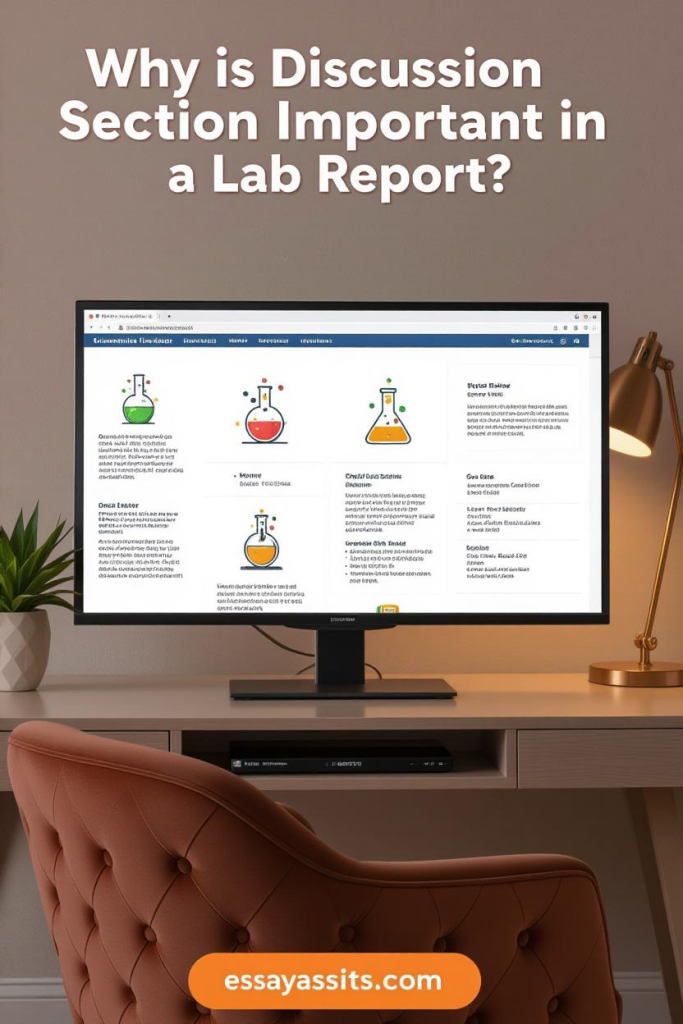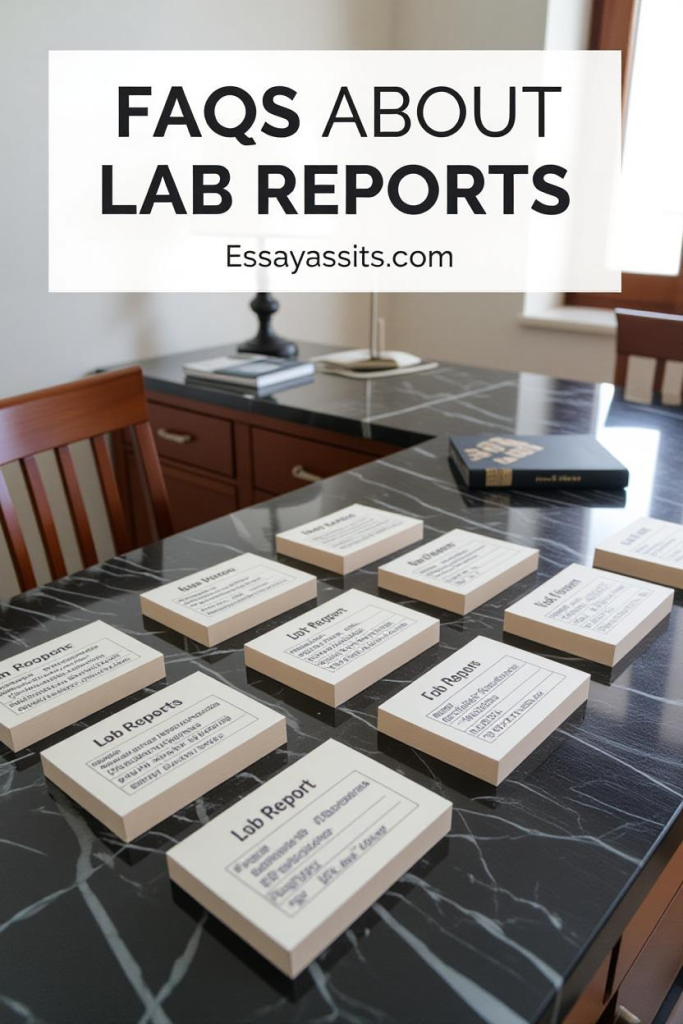
Written by: Kennedy Muthee
Discussion for a Lab Report: A Student-Friendly Introduction
Writing the discussion section of a lab report often feels like the most challenging part of scientific writing. After all, you’ve already collected data, drawn graphs, and summarized results—so what’s left?Actually, this is the most important part of your report. The discussion is where your experiment comes alive. It’s where you interpret what your results mean, connect them to existing theories, and explain their significance. A lab report is a structured document that describes a scientific experiment — what you did, why you did it, what you found, and what it means. It’s used in science, engineering, and academic courses to communicate experimental results clearly and logically.
A lab report is a written summary of an experiment that explains the purpose, methods, results, and conclusions.
It helps readers understand the experiment’s process, findings, and scientific significance. At Essayassits.com we help students get A plus Lab reports and also offer any other academic writing assistance. https://essayassists.com/blog/
🧩 Main Parts of a Lab Report
Most lab reports follow this standard structure:
- Title – A short, clear description of the experiment.
Example: Effect of Temperature on Enzyme Activity. - Abstract – A brief summary of the experiment (purpose, methods, main results, and conclusion).
- Introduction – Explains background information, research question, and hypothesis.
- Materials and Methods – Describes what you used and how you conducted the experiment.
- Results – Presents data and observations (often with tables or graphs).
- Discussion – Interprets results, explains their meaning, and compares them to your hypothesis.
- Conclusion – Summarizes the overall findings and their significance.
- References – Lists the sources or research materials used.
🎯 Purpose of a Lab Report
- To record experimental procedures and data.
- To analyze results and draw logical conclusions.
- To demonstrate understanding of scientific principles.
- To communicate findings clearly to others (teachers, classmates, or researchers).
🧠 In Simple Terms
A lab report is like telling the story of your experiment — from what you wanted to test, how you tested it, what you found, and what it means in science.
In simple terms, your discussion answers three main questions:
- What did your results show?
- Why did they turn out that way?
- What can be learned or improved from them?
Think of it as your chance to showcase critical thinking, scientific reasoning, and clear communication—the qualities your instructor wants to see most.
🧠 Why Is the Discussion Section Important in a Lab Report?

The discussion section is one of the most important parts of a lab report because it shows your ability to think critically about your experiment. While the results section presents what you found, the discussion explains what thoshttps://essayassists.com/blog/e findings mean, why they occurred, and how they relate to your hypothesis and the broader scientific context.
In other words, the discussion transforms data into understanding. It demonstrates your ability to interpret results, identify patterns, recognize errors, and connect your experiment to established scientific theories or prior research.
Here’s why the discussion section matters so much:
1. It Interprets the Results
The discussion helps readers understand the significance of your data. Instead of simply restating numbers, you explain why the results occurred based on scientific principles or background research.
✅ Example: “The higher enzyme activity at 37°C supports the theory that human enzymes perform optimally at body temperature.”
2. It Evaluates the Hypothesis
This section directly addresses whether your hypothesis was supported or rejected by your findings. It ties your experiment back to its original purpose and shows whether your predictions were accurate.
💡 Tip: Always state your conclusion clearly — for instance, “The data supported the hypothesis that light intensity increases photosynthetic rate up to a certain threshold.”
3. It Demonstrates Critical Thinking
A strong discussion shows that you can analyze unexpected outcomes or inconsistencies rather than ignoring them. Acknowledging potential errors or limitations demonstrates maturity and scientific honesty.
✅ Example: “The slight variation in Trial 3 may have resulted from inconsistent temperature control during measurement.”
4. It Connects Your Findings to Scientific Context
By comparing your results to existing research or textbook principles, you show that you understand how your experiment fits into the larger scientific framework.
✅ Example: “Similar to findings by Chen (2022), the data indicate that soil pH significantly affects plant growth rates.”
5. It Highlights the Significance of Your Work
Your discussion should answer the question: “Why does this matter?”
This is your opportunity to show how your results can be applied in real-world scenarios or how they contribute to future research.
✅ Example: “These findings suggest that using biodegradable polymers could be an effective way to reduce plastic waste in packaging industries.”
6. It Reflects Scientific Reasoning and Understanding
Finally, the discussion section is where you prove that you understand not only what happened in your experiment but also why it happened. It’s your chance to showcase analytical skills, scientific logic, and the ability to think beyond raw data.
In summary:
The discussion section is essential because it turns experimental data into meaningful insight. It shows your understanding of the experiment, your ability to reason scientifically, and your skill in connecting results to hypotheses, literature, and real-world relevance.
Would you like me to write a short paragraph version (about 150 words) of this section that could fit neatly into an actual lab report submission?
Key Components of a Strong Lab Report Discussion

A high-quality discussion section should include eight essential components, each with a specific purpose:
| Component | Purpose | Why It Matters |
| 1. Summary of key outcomes | Briefly outline your main findings without repeating raw data. | Gives readers a snapshot of what happened. |
| 2. Hypothesis evaluation | State clearly whether your hypothesis was supported or not. | Connects results directly to research goals. |
| 3. Interpretation of results | Explain why your findings occurred. | Shows deep scientific understanding. |
| 4. Relation to expectations | Compare results to what you predicted or to theoretical expectations. | Highlights alignment or discrepancy with theory. |
| 5. Comparison with existing literature | Reference previous studies or lab manuals. | Adds credibility and scientific context. |
| 6. Explanation of anomalies | Discuss unexpected results or inconsistencies. | Demonstrates honesty and analytical thinking. |
| 7. Discussion of limitations | Identify weaknesses or potential errors. | Builds transparency and reliability. |
| 8. Significance and future research | Explain why your results matter and what could be done next. | Shows forward-thinking and engagement with science. |
Each of these elements transforms your discussion from a summary into an interpretive analysis.
Here’s a clear step-by-step guide on how to write a Discussion section for a lab report — explained simply and with examples.
🧪 Step-by-Step: How to Write a Discussion for a Lab Report
Step 1: Restate the Purpose of the Experiment
Start your discussion by briefly reminding readers what the experiment aimed to test or investigate.
Keep it short — one or two sentences.
Example:
The purpose of this experiment was to determine how temperature affects the rate of enzyme activity in catalase.
Step 2: Summarize the Key Findings
State the main results without repeating all the data. Focus on the trends or patterns that answer your research question.
Example:
The results showed that enzyme activity increased with temperature up to 40°C but declined sharply beyond that point.
Step 3: Explain What the Results Mean
Interpret your findings. Explain why you got those results using scientific reasoning.
Relate them to theories, laws, or previous studies.
Example:
The increase in reaction rate up to 40°C aligns with the theory that higher temperatures speed up molecular collisions. The decline after 40°C likely occurred because high temperatures denatured the enzyme.
Step 4: Compare with Expected Results or Hypothesis
State whether the results support or contradict your initial hypothesis.
If something unexpected happened, explain it logically.
Example:
These findings supported the hypothesis that enzyme activity would peak at an optimal temperature. However, the activity decreased more rapidly than predicted, possibly due to experimental errors in temperature control.
Step 5: Address Errors or Limitations
Acknowledge any sources of error, limitations, or uncertainties in your experiment. This shows critical thinking.
Example:
Possible sources of error include inaccurate temperature readings and inconsistent enzyme concentrations between trials.
Step 6: Suggest Improvements
Briefly explain how the experiment could be improved if done again.
Keep suggestions realistic and connected to your limitations.
Example:
Future experiments could use a digital thermometer for more precise temperature control and repeat trials to increase accuracy.
Step 7: Link to Real-World or Scientific Context
Explain the broader significance of your findings — why they matter in science or everyday life.
Example:
Understanding enzyme temperature sensitivity is important for industries like food processing and biotechnology, where enzymes are used under controlled conditions.
Step 8: End with a Strong Concluding Statement
Wrap up with a one-sentence conclusion summarizing the overall takeaway of your experiment.
Example:
Overall, the experiment confirmed that catalase activity depends strongly on temperature, with optimal function around 40°C.
✅ Summary Table
| Step | What to Include | Example Focus |
| 1 | Restate purpose | “To test how temperature affects enzyme rate.” |
| 2 | Summarize key findings | “Activity increased up to 40°C, then dropped.” |
| 3 | Interpret results | “Higher temp speeds reactions until enzyme denatures.” |
| 4 | Compare with hypothesis | “Supported hypothesis; drop sharper than expected.” |
| 5 | Mention errors | “Temperature readings may have fluctuated.” |
| 6 | Suggest improvements | “Use digital thermometer; repeat trials.” |
| 7 | Broader impact | “Relevant for industrial enzyme use.” |
| 8 | Conclude | “Catalase works best around 40°C.” |
🚫 Common Mistakes to Avoid in a Lab Report Discussion

1. Repeating Results Instead of Explaining Them
Mistake: Simply restating what you already said in the results section.
Fix: Focus on why the results occurred, not what they were.
✅ Example: Instead of “The enzyme worked faster at 40°C,” explain “The enzyme’s active site fit the substrate best at 40°C, increasing reaction rate.”
2. Ignoring the Hypothesis
Mistake: Forgetting to say whether your hypothesis was supported or not.
Fix: Always link your findings back to your original prediction.
✅ Example: “The hypothesis that enzyme activity would increase with temperature up to 40°C was supported.”
3. Overlooking Errors or Limitations
Mistake: Pretending everything went perfectly.
Fix: Be honest about experimental errors — it shows scientific thinking.
✅ Example: “Minor temperature fluctuations may have affected the reaction rate.”
4. Making Claims Without Evidence
Mistake: Giving explanations without connecting them to your data.
Fix: Always back your statements with specific results or references.
✅ Example: “As shown in Figure 2, enzyme activity decreased after 40°C, supporting the theory of heat denaturation.”
5. Using Vague or Overly General Language
Mistake: Writing things like “It worked well” or “It was accurate.”
Fix: Use precise, scientific terms and measurable details.
✅ Example: Replace “It worked well” with “The reaction proceeded efficiently with minimal delay at optimal temperature.”
6. Ignoring Contradictory or Unexpected Results
Mistake: Skipping results that don’t fit your hypothesis.
Fix: Discuss them openly and suggest possible reasons.
✅ Example: “Although one trial showed slower activity at 30°C, this may have been due to pipetting error.”
7. Forgetting the Bigger Picture
Mistake: Failing to connect findings to scientific theory or real-world context.
Fix: Explain why your results matter beyond the lab.
✅ Example: “Understanding enzyme temperature tolerance helps improve industrial enzyme use.”
8. Writing a Conclusion That’s Too Long or Off-Topic
Mistake: Turning the conclusion into another results summary or a long reflection.
Fix: End with a short, focused statement that summarizes your main finding.
✅ Example: “In conclusion, enzyme activity peaked at 40°C, confirming temperature’s effect on reaction rate.”
9. Poor Organization
Mistake: Mixing explanations, results, and errors randomly.
Fix: Follow a clear order — purpose → findings → interpretation → errors → conclusion.
10. Using Informal or Emotional Language
Mistake: Writing like a story or giving opinions.
Fix: Keep the tone formal and objective.
🚫 “I think the experiment went great.”
✅ “The experiment produced consistent results supporting the hypothesis.”
🧪 Example Discussion Paragraph
The purpose of this experiment was to investigate how temperature affects the activity of the enzyme catalase. The results showed that the reaction rate increased steadily from 20°C to 40°C but decreased sharply at 60°C. This pattern supports the hypothesis that enzyme activity rises with temperature until the enzyme begins to denature. The increase at lower temperatures can be explained by the greater kinetic energy of molecules, which leads to more frequent collisions between the enzyme and substrate. However, at 60°C, the enzyme’s structure likely changed, preventing it from binding effectively to hydrogen peroxide. Minor errors, such as slight variations in temperature and timing during trials, may have affected the precision of the results. Future experiments could use a digital thermometer and automated timing system to improve accuracy. Overall, the findings confirm that catalase functions best at moderate temperatures and loses efficiency when exposed to excessive heat.
🔍 Why This Example Works
- Starts with the purpose.
- Summarizes key results clearly.
- Explains results using scientific reasoning.
- Connects to the hypothesis.
- Acknowledges errors and suggests improvements.
- Ends with a strong concluding statement.
🧾 Conclusion: Your Perfect Discussion Section
Writing the discussion section of a lab report may seem challenging at first, but it’s simply about explaining what your results mean and why they matter. A strong discussion connects your findings to your hypothesis, supports them with scientific reasoning, and acknowledges any limitations honestly. Avoid repeating data — instead, focus on interpretation and understanding.
Remember, the best discussions are clear, logical, and reflective. They show that you understand not only what happened in your experiment but also why it happened. With practice, you’ll be able to write a discussion that’s concise, insightful, and perfectly aligned with the scientific method — turning your lab results into meaningful conclusions.

1. What is the purpose of a lab report?
A lab report’s main purpose is to communicate the details and results of an experiment clearly. It shows what you did, what you found, and what those findings mean scientifically.
2. How is a lab report different from a research paper?
A lab report focuses on a specific experiment, using a fixed structure (introduction, methods, results, discussion).
A research paper is broader — it analyzes many studies or experiments to support an argument or theory.
3. What should be included in a good lab report?
A strong lab report usually has:
- Title
- Abstract
- Introduction
- Materials and Methods
- Results
- Discussion
- Conclusion
- References
Each section has a specific role in explaining your experiment step-by-step.
4. How long should a lab report be?
It depends on your subject and level.
- High school: 2–4 pages
- College or university: 5–10 pages
Focus on clarity and completeness, not length.
5. What’s the difference between the Results and Discussion sections?
- Results: Present your data (what you found).
- Discussion: Interpret your data (what it means).
The results section should be factual and objective; the discussion explains why those results happened.
6. How do I write a good lab report discussion?
- Restate your experiment’s purpose.
- Summarize key findings.
- Explain results using scientific reasoning.
- Compare with your hypothesis.
- Mention errors or limitations.
- Suggest improvements.
- End with a clear concluding statement.
7. Should I write a lab report in first person (“I” or “we”)?
Most lab reports use third person and past tense (e.g., “The solution was heated to 60°C”).
However, some instructors may allow first person — always check your lab guidelines.
8. How do I make my lab report look professional?
- Use clear headings for each section.
- Include tables and graphs where needed.
- Check spelling, grammar, and formatting.
- Follow the required citation style (APA, MLA, etc.).
9. Why is the Discussion section so important?
It shows your understanding of the experiment. Anyone can collect data — but the discussion reveals whether you truly grasp what your results mean and how they connect to scientific concepts.
10. Can I get help writing a lab report?
Yes! Many students use online writing tools or academic support services (like EssayAssists.com) to get help with structuring, proofreading, or editing their lab reports while still doing their own experiments and analysis.
